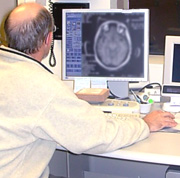
The Brain Imaging and Analysis Center (BIAC) brings together scientists from throughout Duke University and the University of North Carolina at Chapel Hill, to find interdisciplinary solutions to fundamental research questions about the human brain. Two key themes underlie research at BIAC. The first is to improve research techniques in neuroimaging through improvements in MR pulse sequence design, applications to high-field fMRI, experimental control, and understanding of brain hemodynamics. Second, BIAC researchers investigate the functional properties of the human brain by incorporating these state-of-the-art research techniques into basic and translational neurosciences. Consistent with these two themes, three research groups in Imaging and Analysis Methodology, Translational Neuroimaging, and Cognitive Neuroimaging are formed within BIAC. The research activities in these groups are actively funded by grants from the National Institute of Neurological Disorders and Stroke, National Institute of Mental Health, National Institute of Aging, National Institute of Drug Abuse, and National Science Foundation. Additional significant funding also comes from the Department of Veterans Affairs.
